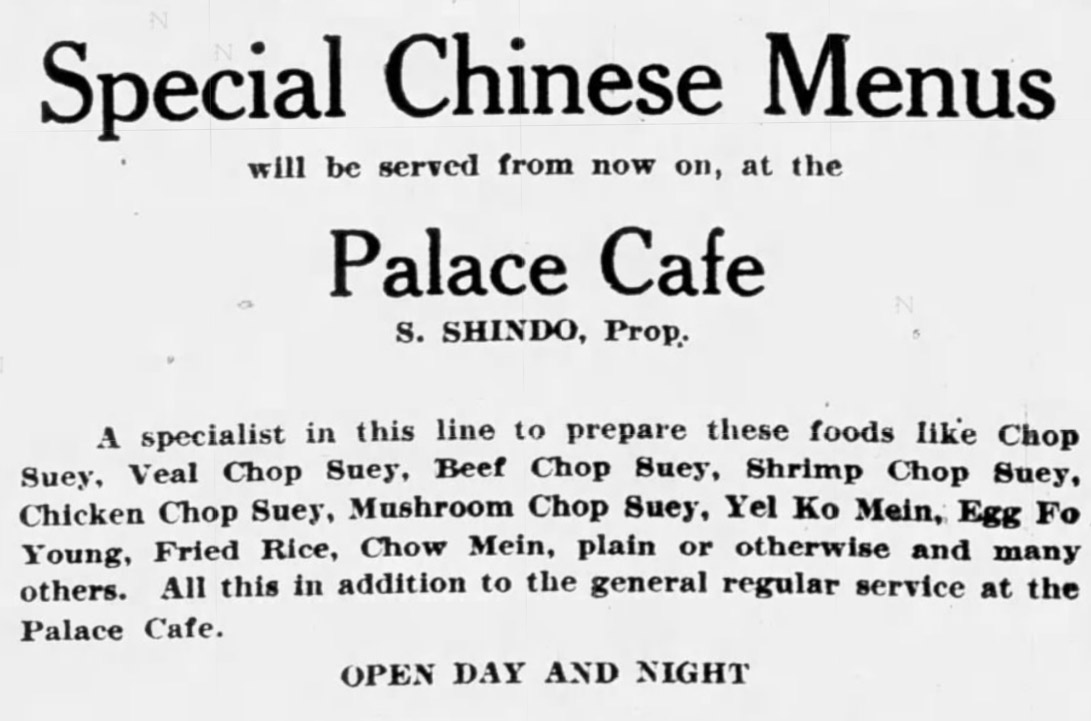


Framed or unframed, desk size to sofa size, printed by us in Arizona and Alabama since 2007. Explore now.
Shorpy is funded by you. Patreon contributors get an ad-free experience.
Learn more.

- Lofty addition
- In 1912
- Keenan Building
- Six years old
- Taken from the P.J. McArdle Roadway?
- It stood only 47 years
- Three track mind
- Incline to the right
- Reach for the sky, 1912 style
- No clean sweep
- Same Job Title, Same Face
- Sadly Lost
- Beautiful ...
- Where you get your kicks
- Aim High
- Pueblo Revival sisters
- Pueblo Neoclassicism
- Milk Man
- Regional dialect.
- Spielberg's inspiration
- Great Photo
- Loaf Story
- Do you still have the Rakes category?
- Could almost be a scene from the 1957 movie 'Hell Drivers'
- The Wages of Fear.
- Conspicuous by their absence
- Got Milk?
- All that aluminum
- No lefties
- Smoke 'em if you've got 'em
Print Emporium
Good American Food: 1942

May 1942. "Grand Island, Nebraska." Home of the "homey" Palace Cafe. Medium format acetate negative by John Vachon for the Farm Security Administration. View full size.
AAF Base, Grand Island
My late father was an engine mechanic on the big WWII bombers (B-17, B-24, B-29). He spent essentially the entirety of his service at the AAF bases in Fort Hayes, Kansas, and Grand Island, Nebraska. Anyone who's ever spent time near a military base knows there are always lots of "tourists."
One reason for Grand Island tourists in 1942
In 1905, in a tiny rental home at 622 W. Division Street in Grand Island (in "Railroad town") a child was born to a recently-married couple with special Shorpy-cred: Uneeda Biscuits Co. salesman William Fonda, and his wife Herberta. The baby was named Henry.
The Fonda family's stay in Grand Island was brief; the next year, the threesome moved east to Omaha, where Henry was raised and developed an interest in theatre.
Fifteen months before this picture was taken, Henry was nominated for an Oscar for playing Tom Joad in John Steinbeck's "The Grapes of Wrath." He didn't win then, but would win one eventually.
Why tourists?
Grand Island would have been a good day's drive east from Denver in the 1940s. It was probably a natural stopping point unless people really wanted to press on more hours to Lincoln or Omaha.
Tourists
Construction started on the nearby Cornhusker Ordnance Plant in March 1942.
Thousands moved there to work at the plant, making Grand Island a boom-town with a shortage of housing.
Suspect "tourist" in this sense would mean "out of towner".
But seriously --
It's a Ford Model T from the last few years of its' run, 1925 or so to '27. Comparing it in size with the brand-new '42 Chevy across the street shows just how much the "low-priced 3" American cars had grown already.
Evolution of transportation
From right hand corner: Walking-bicycling-Model T Ford-Model A Ford-current Chevrolet.
Mystified
What would have been un-American food and service in the middle of 1942 in the middle of Nebraska? Somehow I doubt that the Caredis Cafe next door is offering moussaka instead of mac and cheese, bifteki instead of burgers or baklava instead of apple pie. But the cooled air and the 24/7 might be a thorn in the side of the New Palace Cafe.
[In the 1920s and '30s, any American restaurant with "Palace" in its name was very likely a chop suey joint serving Chinese food. Grand Island's original Palace Cafe, whose owner Saburo Shindo was Japanese, was one of them. - Dave]
Rare bird sighting!
Photographer Vachon, perhaps by chance, captured the ultra-rare auto seen here in the closest parking space on the right-hand side.
The famed Borden Dairy firm decided, in the mid 1920s, to branch into another industry, and thus was born Borden's Eagle Automobiles, Inc. There was just one model, shown here: the Borden's Eagle Condensed Special.
Unfortunately, the demand for such a truncated car just wasn't enough to justify the investment and the venture was unsuccessful, folding after just two years.
Superb (Again)
Vachon wasn't one of the photographers I learned about back when that was my field of study. But I'm going to make up for lost time. These Shorpy sharings induced me to buy a couple of his books. I eagerly await their arrival.
What tourists?
Both cafes seem to be catering to tourists. I wonder how big the hospitality business was in Grand Island 5 months into WWII. The Palace Cafe looks like it was a movie house in a past life, what with that sidewalk canopy/marquee and the vertical signage.
Both the Palace Cafe and Caredis Cafe
have large signs directed at "tourists" ... what made Grand Island, Nebraska a tourist hot spot in 1942?
On the horns of a dilemma
I'm drawn to the courteous service and homey atmosphere at the New Palace -- not to mention the modern rest rooms and reasonable prices -- but then at Caredis I am welcome "just as I am" and am invited to inspect their ... something. Whatever it is, I'd like to check it out. Since I'm so welcome.
In other news, the woman walking away from the camera on the far right-hand side of the photo instantly struck me as resembling Loretta, the female assassin who walks towards Robert Redford a/k/a Johnny Hooker in the alleyway in The Sting. Loretta wasn't wearing a headscarf, but still. Gives me chills just thinking about it.
Now, good ol' American marketing.
Lots of building still there, but that monster in the center is gone.

























On Shorpy:
Today’s Top 5